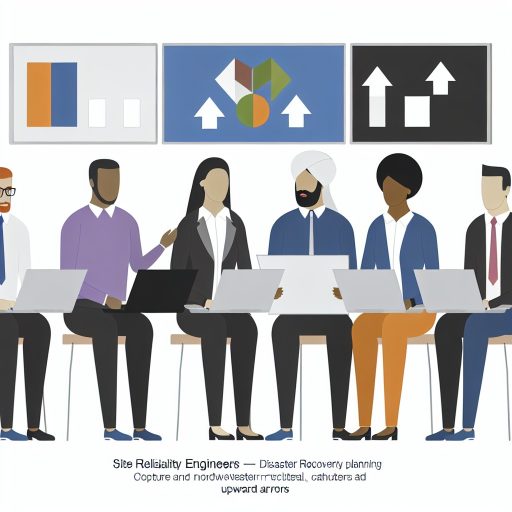Introduction
A release manager holds a crucial role in software development.
They coordinate and manage the release process effectively.
Continuous delivery is a practice that keeps software always in a releasable state.
This approach enables frequent and reliable software releases.
Role of a Release Manager
- Planning and scheduling release cycles to match business objectives.
- Collaborating with development, testing, and operations teams to ensure smooth releases.
- Identifying and mitigating risks related to software releases to reduce disruptions.
- Overseeing deployment of software releases to guarantee success and error-free delivery.
- Communicating release progress, status, and issues to relevant stakeholders clearly.
Significance of the Release Manager in Continuous Delivery
- Plays a vital role in maintaining high quality of software releases.
- Manages release processes efficiently, streamlining the overall development workflow.
- Facilitates continuous improvement by analyzing release outcomes and feedback.
- Promotes collaboration among teams, resulting in smoother and more effective release cycles.
- Contributes to customer satisfaction through timely and reliable software releases.
The release manager role is indispensable for successful continuous delivery.
They ensure efficient software release management in modern development practices.
Responsibilities of a Release Manager in overseeing the release process
Ensure timely delivery of software releases.
Ensure successful delivery of software releases.
Coordinate release activities across multiple teams and departments.
Manage the release calendar to avoid conflicts.
Manage the release schedule to avoid conflicts.
Identify risks that could impact the release.
Identify dependencies that could impact the release.
Collaborate with developers to resolve issues.
Collaborate with testers to resolve issues.
Collaborate with other stakeholders to resolve issues.
Implement best practices for release management.
Implement best practices for continuous delivery.
Monitor the progress of each release to meet deadlines.
Track the progress of each release to meet deadlines.
Transform Your Career Today
Unlock a personalized career strategy that drives real results. Get tailored advice and a roadmap designed just for you.
Start NowDocument release procedures.
Maintain version control of software.
Provide post-release support for continuous improvement.
Provide feedback for continuous improvement.
- Ensure timely delivery of software releases.
- Coordinate release activities across many teams and departments.
- Manage the release calendar and schedule.
- Identify risks and dependencies impacting the release.
- Collaborate with developers, testers, and stakeholders.
- Implement best practices for release management and delivery.
- Monitor and track release progress.
- Document procedures and maintain version control.
- Provide post-release support and feedback.
Importance of coordination and communication with different teams within the organization
Facilitate collaboration and alignment between development and operations teams.
Ensure clear communication of release plans.
Communicate milestones and updates clearly.
Address concerns that arise during the release process.
Address conflicts that arise during the release process.
Promote a culture of transparency, ownership, and accountability.
Align release goals with business objectives.
Align release goals with customer requirements.
Foster a team environment that values feedback.
Foster continuous learning within the team.
Establish channels for feedback and suggestions.
Establish channels for issue resolution.
Encourage cross-functional teams to work together.
Encourage teams to work towards common goals.
Celebrate successes to drive improvement.
Learn from failures to drive continuous improvement.
Transform Your Career Today
Unlock a personalized career strategy that drives real results. Get tailored advice and a roadmap designed just for you.
Start Now- Facilitate collaboration and alignment between development and operations teams.
- Ensure clear communication of release plans, milestones, and updates.
- Address concerns and conflicts during the release process.
- Promote transparency, ownership, and accountability.
- Align release goals with business objectives and customer needs.
- Foster a feedback-driven and continuous learning team environment.
- Establish feedback, suggestion, and issue resolution channels.
- Encourage cross-functional collaboration towards shared goals.
- Celebrate achievements and learn from setbacks.
Collaboration with development and operations teams
- Working closely with developers to ensure software features are released on time.
- Liaising with operations teams to ensure smooth deployment and monitoring of releases.
Release managers play a crucial role in the successful implementation of Continuous Delivery practices within an organization.
One of the key responsibilities of a release manager is to collaborate effectively with both development and operations teams.
This collaboration ensures that the release process is streamlined and efficient.
Here are some ways in which release managers collaborate with these teams:
Working closely with developers
- Release managers work closely with developers to understand the timelines and dependencies of software features that need to be released.
- They ensure that developers adhere to the release schedule and provide necessary support to expedite the release process.
- Release managers also coordinate with developers to address any technical issues or bugs affecting the release.
Liaising with operations teams
- Release managers collaborate with operations teams to plan and coordinate the deployment of releases to production environments.
- They work with operations teams to ensure the deployment process is smooth and does not disrupt normal system operations.
- Release managers assist operations teams in monitoring release performance and troubleshooting any issues that arise.
Collaboration with development and operations teams is essential for a release manager to ensure successful Continuous Delivery implementation.
By working closely with these teams, release managers streamline the release process and improve communication.
This collaboration enhances the overall efficiency of the software delivery pipeline.
Delve into the Subject: Penetration Testing: Real-World Case Studies
Implementing and managing release pipelines is an essential task for release managers.
They create automated release pipelines to streamline the release process.
- Creating automated release pipelines to streamline the release process.
- Identifying bottlenecks and continuously improving release processes for efficiency.
Release managers play a crucial role in ensuring that software is delivered efficiently and effectively to end users.
One key responsibility is implementing and managing release pipelines.
Let us explore this topic in greater detail.
Creating Automated Release Pipelines
Release managers are tasked with creating automated release pipelines.
A well-defined pipeline ensures software deployments are consistent, reliable, and repeatable.
Automation reduces human errors and accelerates software delivery.
This enables teams to release software more frequently and confidently.
Identifying Bottlenecks and Improving Efficiency
Another critical responsibility is identifying bottlenecks in the release process.
Release managers analyze pipelines to find inefficiencies or roadblocks.
Proactively addressing issues optimizes the release process.
Transform Your Career Today
Unlock a personalized career strategy that drives real results. Get tailored advice and a roadmap designed just for you.
Start NowContinuous improvement ensures the process remains efficient, reliable, and scalable.
By implementing and managing release pipelines effectively, release managers ensure successful software delivery.
Automating pipelines and improving processes are vital for efficient releases to end users.
See Related Content: AI Specialist: Remote Work Opportunities
When it comes to the role of a Release Manager in Continuous Delivery, one key responsibility is ensuring compliance and security.
Verifying that releases meet regulatory compliance standards
Release Managers play a crucial role in ensuring that all software releases adhere to regulatory compliance standards.
This includes making sure the software meets industry-specific regulations and guidelines such as GDPR, HIPAA, or PCI compliance.
By verifying that releases meet these standards, Release Managers help mitigate potential legal and financial risks for the organization.
Implementing security measures to protect software during the release process
In addition to regulatory compliance, Release Managers are responsible for implementing security measures to protect software during the release process.
This includes ensuring sensitive data is encrypted, implementing access controls, and conducting security testing before releasing software to production.
By proactively addressing security concerns, Release Managers help minimize the risk of data breaches and other security incidents.
Ensuring compliance and security is a critical aspect of the Release Manager’s role in Continuous Delivery.
By verifying regulatory compliance standards and implementing security measures, Release Managers play a vital role in safeguarding the organization’s software and data.
Explore Further: Common Misconceptions About IT Consulting
Risk management and contingency planning
- Identifying potential risks that could impact the release process
- Developing contingency plans to address unexpected issues and minimize disruptions
As a Release Manager in a Continuous Delivery environment, one of the crucial aspects of your role is to effectively manage risks and plan for contingencies.
By proactively identifying potential risks that could impact the release process, you can minimize disruptions and ensure a smooth and successful delivery.
Here are some key strategies for risk management and contingency planning in the context of Continuous Delivery.
Identify potential risks
It is essential to conduct a thorough analysis of the release process and identify any potential risks that could arise.
This could include technical issues, resource constraints, dependencies on external systems, or any other factors that could impact the release timeline or quality.
Prioritize risks
Once you have identified potential risks, it is important to prioritize them based on their potential impact on the release process.
Transform Your Career Today
Unlock a personalized career strategy that drives real results. Get tailored advice and a roadmap designed just for you.
Start NowBy prioritizing risks, you can focus on addressing the most critical issues first and allocate resources accordingly.
Develop contingency plans
For each identified risk, develop a contingency plan that outlines how you will address the issue if it occurs.
Contingency plans should include specific actions, timelines, and responsible parties to ensure a swift and effective response to unexpected issues.
Test contingency plans
It is crucial to test your contingency plans before an actual release to ensure their effectiveness.
By simulating potential risk scenarios and executing your contingency plans, you can identify any gaps or shortcomings and make necessary adjustments to improve readiness.
Regularly review and update plans
Risk management and contingency planning are ongoing processes that require regular review and updates.
As the release process evolves and new risks emerge, make sure to revisit and revise your contingency plans to ensure they remain relevant and effective.
By effectively managing risks and planning for contingencies, Release Managers can mitigate disruptions, ensure successful deliveries, and maintain a high level of confidence in the Continuous Delivery process.
Delve into the Subject: Common IT Risks and How IT Risk Managers Address Them

Monitoring and analyzing release performance is crucial.
- Tracking key metrics to evaluate the success of release processes.
- Analyzing data to make data-driven decisions for future releases.
Release managers play a crucial role in the Continuous Delivery process.
They closely monitor and analyze the performance of each release.
This involves tracking key metrics and analyzing data to make informed decisions for future releases.
Tracking key metrics to evaluate release success
One essential task of a release manager is to track key metrics that evaluate release process success.
These metrics include deployment frequency, lead time for changes, and time to restore service after failures.
By tracking these metrics, release managers identify bottlenecks in the release pipeline.
They determine areas for improvement and measure the impact of process changes on efficiency.
This data-driven approach allows continuous optimization of the release process.
Using data analysis to improve future release decisions
Release managers analyze collected data to make data-driven decisions for future releases.
They examine trends and patterns to predict potential issues and address them proactively.
Transform Your Career Today
Unlock a personalized career strategy that drives real results. Get tailored advice and a roadmap designed just for you.
Start NowThis improves the overall release process and reduces risks.
Data analysis helps identify factors contributing to delays, failures, and successful releases.
Managers prioritize tasks effectively, allocate resources efficiently, and mitigate release cycle risks.
Tracking and analyzing release performance are critical in Continuous Delivery.
Release managers ensure continuous process improvement and the success of future releases.
Communication and Stakeholder Management
- Keeping all stakeholders informed about the progress of release cycles.
- Handling feedback and addressing concerns from different teams involved in the release process.
Release managers play a crucial role in communication and stakeholder management in continuous delivery.
They serve as a bridge between various teams involved in the release cycle.
Release managers ensure that everyone is informed about the progress of releases.
One key responsibility is to keep all stakeholders updated on the status of release cycles.
This involves communicating with teams such as development, quality assurance, operations, and project management.
They ensure that everyone knows the timelines and deliverables for each release.
Besides informing stakeholders, release managers handle feedback and address concerns from different teams.
They actively listen to feedback from various teams and understand their concerns.
Release managers work towards resolving issues during the release cycle.
Effective communication is key to the success of continuous delivery.
Release managers ensure all teams are aligned and focused on a common goal.
Keeping stakeholders informed and addressing concerns helps create a collaborative environment.
This environment is essential for successful continuous delivery practices.
Release managers must possess strong interpersonal skills to communicate effectively with all stakeholders.
They handle challenging situations with ease and listen actively to feedback.
Transform Your Career Today
Unlock a personalized career strategy that drives real results. Get tailored advice and a roadmap designed just for you.
Start NowThey provide clear and concise information to various teams involved in the release process.
Communication and stakeholder management are crucial aspects of the release manager’s role in continuous delivery.
By effectively communicating and addressing concerns, release managers ensure smooth and successful release cycles.
The release cycles meet the needs of the organization and its customers.
Continuous Improvement and Learning
- Encouraging a culture of continuous improvement within the team
- Learning from past releases to make informed decisions and optimize future release cycles
Continuous improvement and learning are crucial aspects of a release manager’s role in continuous delivery.
By fostering a culture of continuous improvement within the team, the release manager can ensure that processes evolve and become more efficient.
One way a release manager encourages continuous improvement is by conducting regular retrospectives after each release.
During retrospectives, team members reflect on what went well, what could be improved, and what actions enhance future releases.
Learning from past releases also plays an essential role for a release manager.
By analyzing data and feedback from previous releases, the release manager identifies patterns and trends to make informed decisions.
If a particular feature consistently causes deployment issues, the release manager works with the development team to fix root causes.
This iterative learning process helps optimize the release cycle and deliver high-quality software consistently.
Furthermore, the release manager leverages tools and metrics to track each release’s success and find areas for improvement.
Monitoring key performance indicators such as deployment frequency, lead time, and mean time to recover provides insights into process efficiency.
These data-driven insights enable the release manager to drive ongoing continuous improvement.
Continuous improvement and learning form foundational principles guiding release managers in continuous delivery.
By encouraging continuous improvement culture, learning from past releases, and using data-driven insights, release managers optimize release cycles effectively.
Role and Impact of Release Managers in Continuous Delivery
The release manager plays a crucial role in continuous delivery processes.
They coordinate and oversee the entire release cycle.
This ensures that software is delivered efficiently and effectively.
Transform Your Career Today
Unlock a personalized career strategy that drives real results. Get tailored advice and a roadmap designed just for you.
Start NowEffective release management is essential for customer satisfaction.
It also helps companies maintain a competitive edge in the market.
By implementing streamlined release processes, release managers contribute significantly to software delivery success.
Additional Resources
Dave Farley’s Weblog | Thoughts on Continuous Delivery and Agile …
Continuous integration and delivery – Azure Data Factory | Microsoft …




